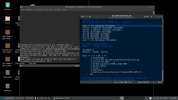Hello to everyone. I've tried to install Arch Linux on bhyve,but it didn't work. I mean,the image created is not able to boot when I use bhyve. I repeated the steps two times. The first time I've issued the commands using FreeBSD and creating the image with the tools and the tecniques provided by FreeBSD and Bhyve. The second time I've switched in Linux and I've repeated the steps creating a new image with qemu / kvm / virt-manager and then I tried to boot it with Bhyve. Below you can see the commands that I have issued. Take in consideration that those commands worked in Linux and with qemu-kvm. I mean,the image produced by these commands can boot in Linux with qemu-kvm-virt-manager but NOT in FreeBSD with bhyve. So,I suspect that there is some bug in the booting procedure of Bhyve. I've highlighted the commands that I have used for installing grub and the efibootmgr in Linux. I suspect (but Im not sure) that the Arch Linux is affected by the same problem that is affected Debian and "Jeff Sipek" talked about this problem in his website :
 blahg.josefsipek.net
blahg.josefsipek.net
when he says :
This is not a Debian bug, but rather bhyve’s EFI support being incomplete. The easiest way around this is to copy the Debian binary into the standard location immediately after installation.
The difference is that he found an easy solution for the incomplete EFI support that prevents Debian from booting,but it's not easy to apply the same method for Arch. Or,at least,I tried,but it didn't work. So,I have a complete Arch installation stored inside an img file that can boot under Linux with qemu-kvm but not under FreeBSD with Bhyve. Someone can give me some suggestions to fix this problem ?
Josef “Jeff” Sipek » Installing Debian under FreeBSD's bhyve
when he says :
This is not a Debian bug, but rather bhyve’s EFI support being incomplete. The easiest way around this is to copy the Debian binary into the standard location immediately after installation.
The difference is that he found an easy solution for the incomplete EFI support that prevents Debian from booting,but it's not easy to apply the same method for Arch. Or,at least,I tried,but it didn't work. So,I have a complete Arch installation stored inside an img file that can boot under Linux with qemu-kvm but not under FreeBSD with Bhyve. Someone can give me some suggestions to fix this problem ?
Code:
loadkeys it
ip link --> enp1s0
ip addr --> 192.168.122.86/24 o dhcpcd
fdisk -l --> /dev/vda1 ; /dev/vda2 ; /dev/vda3
cfdisk /dev/vda
GPT
new / 512M / EFI system
new / 4G / Linux Swap
new / 195G / Linux System
mkfs.vfat -F32 /dev/vda1
mkfs.ext4 /dev/vda3
mkswap /dev/vda2
mount /dev/vda3 /mnt
mkdir -p /mnt/boot/efi
mount /dev/vda1 /mnt/boot/efi/
swapon /dev/vda2
reflector --verbose --country Italy --sort rate --save /etc/pacman.d/mirrorlist
pacstrap /mnt base base-devel linux linux-firmware openssh firefox nano
genfstab -U -p /mnt > /mnt/etc/fstab
arch-chroot /mnt /bin/bash
nano /etc/locale.gen
locale-gen
echo LANG=it_IT.UTF-8 > /etc/locale.conf
export LANG=it_IT.UTF-8
nano /etc/vconsole.conf --> KEYMAP=it ; EDITOR=nano
export EDITOR=nano
ln -s /usr/share/zoneinfo/Europe/Rome /etc/localtime
hwclock --systohc --utc
echo "arch-efi-kvm-bhyve" > /etc/hostname
pacman -S net-tools dhcpcd netctl
systemctl enable dhcpcd
pacman -S iwd wpa_supplicant wireless_tools dialog iw
systemctl enable iwd
passwd
useradd -m -G wheel -s /bin/bash marietto
passwd marietto
visudo uncomment (uncomment to allow members of group wheel to execute any command)
---> pacman -S grub efibootmgr os-prober
---> grub-install
---> grub-mkconfig -o /boot/grub/grub.cfg
exit
reboot
pacman -S xf86-video-intel or nvidia
pacman -S xorg-server xorg-xinit
pacman -S
GNOME : gnome gnome-extra gnome-initial-setup
KDE : plasma kde-applications xdg-user-dirs sddm
LXQT : lxqt breeze-icons sddm xdg-user-dirs
MATE : mate mate-extra xdg-user-dirs lightdm lightdm-gtk-greeter
systemctl enable lightdm
pacman -S networkmanager
systemctl enable NetworkManager
systemctl disable dhcpcd
pacman -S pipewire-pulse
reboot


